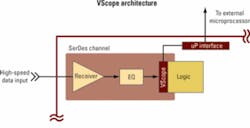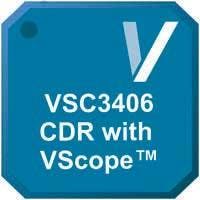by Stephenm Hardy
Vitesse Semiconductor Corp. (www.vitesse.com) says it has developed a technology that enables design engineers and end users to view waveforms within an IC, thus improving signal analysis capabilities. The company plans to incorporate the technology, called VScope, into chips for storage array, router/switch, server, and video distribution applications.
The first such chip, the VSC3406 6.375-Gbit/sec multirate backplane transceiver, was introduced in early February.
According to Juan Garza, product marketing manager for signal integrity products at Vitesse, the advent of several multigigabit protocols across a variety of applications has made signal integrity a more important item on the agenda of design engineers — and one that is more difficult to deal with as well. For example, equalization technology has evolved in an attempt to keep pace with high-speed equipment and network demands to "clean up" distorted signals. However, typical oscilloscope-based measurements may not provide all the information designers need to accurately test equalization performance.
"Oscilloscopes can't reach inside to [capture] what the cleaned-up signal looks like inside the chip, which is what the logic portion of the chip is dealing with. And they're left to probe outside the chip and then extract via simulation or additional circuitry inside the oscilloscope what the packaging effects are, what the equalization effects could be," Garza explains. "Essentially, there's a level of extraction that needs to be done to estimate what the signal might look like inside the chip – but it's not a real probe into the circuit of the chip."
Garza says that Vitesse has removed this blind spot with its most recent advance. "The VScope technology addresses this by building in circuitry inside the clock data recovery portion of our transceivers [to provide] this oscilloscope function," says Garza. "What we're doing is basically probing the live signal with the same circuit that's transmitting the signal. So it's actually the signal inside the IC; it's not an estimation."
As illustrated in the figure, Vitesse integrates the VScope technology within the SerDes channel at the input receiver. A dual-channel parallel sampling technique taps the incoming signal from the channel after the equalization function. The results of the tap, which Garza asserts does not affect the incoming stream, are then sent to an external microprocessor via a standard two-wire serial interface — "essentially an I2C that can be mapped to a USB," in Garza's words — with almost all of the processing performed off chip. The technology has less than a 5% effect on power dissipation and almost no effect on chip size, according to Garza.
The technology can deliver the waveform information to a standard PC. This not only enables an individual engineer to view the measurements at the desktop, but also supports collaborative design work in which multiple engineers can view the signal simultaneously, almost regardless of where they are located.
The waveform information can support a variety of signal measurements, including Q factor, jitter, and rise/fall time measurements. It can also augment algorithms to improve optimal sampling point calculations. Vitesse touts the VScope technology as the first to enable true in-line imaging of real-time data streams on a per-pin basis, as each channel in a chip can have VScope capabilities. Garza expects that VScope technology will have a significant impact on backplane design and signal integrity analysis, particularly since it will make it easier for engineers to quickly view the results of their efforts to tune signals to reduce jitter or perform other debug operations.
Garza says VScope provides better accuracy versus standard external measurement methods because it reflects the true behavior of the data stream as it is captured. This avoids correlation errors between the measurement circuitry and live data path that might occur by using probes.
That said, Vitesse doesn't expect to make the oscilloscope obsolete. "By all means, we're not saying that oscilloscopes are going to be any less needed once this technology is deployed. What we're saying is that you now have information that wasn't there before," Garza says.
In addition to its value to design engineers, VScope technology eventually should prove beneficial in the field, Garza adds. For example, carriers and other system users can take advantage of the VScope capabilities to monitor system and network health once VScope-enabled equipment is deployed. This remote monitoring capability in essence puts oscilloscope functions within the network where they wouldn't appear previously, he says.
The new technology has caught the attention of the analyst community. "Vitesse's approach to embedded waveform viewing technology will certainly drive signal analysis across the network, resulting in greater network reliability for end users," according to Will Strauss, principal analyst for Forward Concepts. "They have brought to market a solution that enables exceptionally high accuracy and newfound visibility critical for cost-effective system debug and remote monitoring. As well, the advanced 'micro-oscilloscope' afforded by VScope will spark the advent of new applications that go beyond the reach of today's lab scope functionality."
VScope-enabled evaluation boards will be available in the second quarter of 2008.


